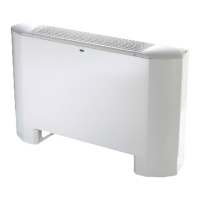28
42N_S 42N_E
English
Controls “A” - “B” - “C” - “D”
Diagnostic warnings
The following alarm situations are indicated:
Blue LED
Flashing Indicates that the control is in frost protection
mode (
).
Red LEDs (group on the right)
Indicates the presence of a fault (sensor failed or
not connected)
Green LED (
) Indicates that the control is in OFF mode forced by
the external contact.
Red / Blue LED
Flashing Indicates that the control is in
“Autotest”
mode
.
Autotest
The “Autotest” function is activated by holding the seasonal changeover
button pressed and at the same time pressing the “
” button three
times within 1 second. In this way it is possible to check the starting of
all fan coils. The blue and red LEDs will begin to ash.
Each of the various units will be activated for 10 seconds in the
following sequence:
Low fan speed.
Medium fan speed.
High fan speed.
CV Motorized cold-water valve.
HV Motorized hot-water valve (only for B and D control).
NTC Control
Power supply connection ( g. 29)
IMPORTANT: Make earth connection prior to any other electrical
connections.
t Before proceeding with the unit connection to the mains supply locate
live L and neutral N, then make connections as shown in the gure 29.
Communication bus connection
t Use connector “J9” (ref. B) on the card to connect the communication
“bus” and make sure to respect the polarities indicated on the card. We
suggest that a BELDEN 9842 cable is used.
IMPORTANT: The unit can be equipped with a “CRC” wire control or
I.R. control which are supplied as accessories. If the “CRC” control is
used, connect it to the “J2” ref. “A” terminal block and congure the
system.
Window contact (Normally open) (g. 29a)
Depending on the contact you need to open, use a small at blade
screwdriver to prize a spring as shown in the gure.
Route the cable through the underlying space.
If the window contact is open for longer than one minute, the unit is
switched to the “frost protect” mode.
The unit will return to normal operation, when the window contact
closes. Connect pin 11 and 12 of connector J2 as shown in the gure.
Conguration of the digital input can be made by software, by setting
it to normally open (default) or normally close modes by means of the
“Service tool” programme.
Presence detecting contact (PD) (g. 29b)
The unit is equipped with a “Presence detecting” contact.
If this input is disabled, the unit follows the pre-set time conguration,
but when this input indicates a presence state for at least 5 seconds, the
unit is forced to operate in the “Occupancy” operating mode.
Connection to be made on pin 5 and 6 of connector J2 as shown in the
gure.
Conguration of the digital input can be made by software, by setting it
to normally open (preferably) or normally close modes.
Other connections (g. 29c)
1. COM IN
2. COM OUT/Occupancy LED
3. GND
4. +12 V d.c.
5. Discrete Input
6. GND
7. Fan Speed In
8. Setpoint In
9. GND
10. AMB Air
11. Discrete Input 2
12. GND
}
"CRC"
Operation of STATUS and CCN leds Fig. 29d
Make all connections and position the covers of the switchboard.
After the unit has been connected to the mains, the red led “Status”
blinks and this can be seen through the window of cover 1.
If the unit is transmitting or receiving data from the remote controls,
the CCN green led ashes.
Warning:
Prior to any other operation on the electric components of the
electric panel, make sure power supply is disconnected. Check
through the special window (shown at the side) that the STATUS RED
led is always o.
The Status red led can ash in two dierent ways:
t Normal operation: regular ashing, one second on, one second o.
t Abnormal operation: the led emits a certain number of pulses
depending on the irregularity detected on the unit. The led remains
on for 60 sec. and o for other 60 sec. with 5 seconds between the two
ashings.
The detectable failures are the following:

